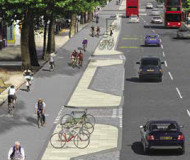6/15/2018
UK: London Mayor Spends $1 Billion On Barely Used Cycle LanesBicycling accounts for between one and two percent of travel in London, England, but it receives the most attention from the mayor.

London mayor Sadiq Khan in 2016 announced his five-year plan to spend £770 million (US $1 billion) to promote bicycling even though it accounts for less than two percent of trips. The latest figures from the UK Department for Transport suggest motorcycles and automobiles are far more important for getting around the British capital, accounting for 78 percent of distance traveled and 62 percent of trips nationwide. Khan is lavishing millions, however, on the mode that accounts for 1.8 percent of trips and less than one percent of the distance traveled.
The centerpiece of London's doubled investment in pedal-powered commuting is the "cycle superhighway," a network of road lanes dedicated solely to bicycle travel connecting central London to the outer boroughs. The lanes were constructed by taking space away from motorized vehicles.
"It is a vitally important initiative aimed at... persuading more people to take up cycling," a Transport for London report explained. "This will contribute significantly toward reducing congestion and pollution, and improving public health."
The cycling superhighways have been controversial since their introduction, even among bicycle advocates who have demanded more space be dedicated to their hobby.
"A number of organizations have expressed concerns about the implications of the new cycle superhighways for motorcyclists," a Transport for London report noted. "The main concern is that the amount of space available to other road users is being reduced, therefore bringing motorcycles into closer contact with other vehicles."
London policies including the congestion tax imposed on automobiles has drastically reduced the use of automobiles throughout the city, with traffic volumes down 10 percent since 2000. At the same time, Transport for London data show congestion has increased 10 percent, despite having fewer cars on the road. In central London, where the tax on automobiles is in full effect, bicycles still account for only 13 percent of daytime trips.
The average across the entire city, however, shows that 37 percent of Londoners rely on buses and trains, 36 percent drive, 24 percent walk, and just 2 percent use bicycles, according to Transport for London mode share data. Demographic data show bicycling is most prevalent among white male Londoners who earn over £100,000 (US $140,000) per year.
"In terms of cycling participation among ethnic groups, cycling is most popular among white Londoners and least popular among black Londoners -- with almost a five-fold difference in frequency of cycling between the two groups," the Transport for London report noted.


